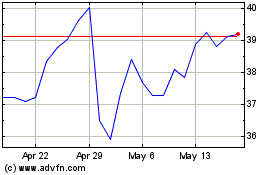A Slice of Snails? Sluggish Demand Mires Pizza Hut, KFC in China
04 September 2018 - 12:11AM
Dow Jones News
By Ese Erheriene
China's once voracious appetite for American fast food is waning
as consumers are lured away by emerging domestic chains and
food-delivery apps.
Two years after owner Yum Brands Inc. spun off its China
business, sales growth is slowing at its KFC and Pizza Hut outlets
in China, as homegrown rivals target young people and an army of
motorcycle couriers make available greater takeout choices.
Yum China Holdings Inc. continues to open dozens of new stores
every month. It has invested in mobile payments, new seasonal menu
items such as abalone--or sea-snail--pizza, and marketing using
online games and pop stars to draw younger diners. Yet sales fell
in the quarter ending June 30, after growth slowed in the two
previous quarters.
Shares in Yum China have slipped 20% since a January high,
bouncing back slightly after a bid by a consortium, led by
Hillhouse Capital Group and which included private-equity firm KKR
& Co., to take the company private. The Wall Street Journal
reported last week that Yum China rejected the bid, which valued
the restaurant operator at more than $17 billion. It would have
been the largest ever take-private deal in Asia, according to data
provider Dealogic.
The consortium believes Yum China has strong brands but needs to
invest to counter pressure from greater local and global
competition, according to a person familiar with the situation.
A Yum China spokesman said that China's rising urban and
middle-class population offered opportunities for growth and that
the company's long-term target was to reach 20,000 stores from just
over 8,000 now. In an August earnings release, Yum China Chief
Executive Joey Wat told investors and analysts that she was
confident in KFC but that Pizza Hut continued to face challenges in
the casual-dining market. The company is still the biggest player
in the country's $600 billion dollar restaurant industry, according
to research by Morningstar.
Louisville, Ky.-based Yum Brands spun off Yum China in late 2016
in a bid to shield itself from the unit's volatile performance,
opting to franchise Chinese operations and collect a royalty
instead. In 1987, Yum Brands was the first major Western fast-food
operator to do business in China. Its China business accounted for
about half the company's revenue before the spinoff.
While KFC has averaged 4% growth since the spinoff, Pizza Hut
has logged only two quarters of same-store sales growth in the past
seven quarters. Total food and beverage sales in China are rising
at more than 10% annually, according to China's statistics
bureau.
The dwindling cachet of American food, safety scares and
changing consumer tastes have made the region a harder place to do
business.
"This is American junk food," said Zhao Yueru, a 24-year-old
education-industry worker, as she tucked into a spicy chicken
sandwich and french fries in KFC in western Shanghai's Changning
district last week. "People with even slightly better tastes eat at
more fancy places."
Food-delivery apps--such as Meituan and Ele.me, which are backed
by technology giants Tencent Holdings Ltd. and Alibaba Group
Holding Ltd. respectively--make it easier for consumers to order
food directly from a vast range of outlets. Yum China has been
expanding delivery capabilities through its KFC and Pizza Hut apps,
which have a combined 180 million users. That has helped lift
delivery sales to 14% of company sales in 2017 from 10% in
2016.
Competition is also rising from homegrown food chains selling
noodles, fast Chinese food and Asian twists on pizza. One of Pizza
Hut's biggest challengers is Shenzhen-based La Cesar Pizzeria,
which serves popular pizzas topped with durian, a pungent Asian
fruit.
Pizza Hut also began offering durian pizzas, as well as other
popular ingredients such as crayfish and abalone. KFC has rebooted
its breakfast offering by selling wrap-style rice rolls filled with
chicken.
"There are more competitors, and consumers are getting more
picky," said Zhou Yang, a food and beverage researcher at market
research firm Dataway Horizon. Ms. Zhou said Yum China's efforts to
connect with younger generations--such as through the popular
online game Onmyoji--haven't had much success.
The rapid expansion of KFC may also have cannibalized sales,
analysts including Bernstein said, with a wave of new store
openings too close to established locations. Sales growth at KFC
stores open for at least a year shrank to zero in the last
quarter.
Yum China said it plans to open between 600 and 650 new stores
in 2018, which is less than last year but up from 2016.
"When I was traveling in foreign countries, I did not see many
Pizza Huts," said Shirley Chen, a 19-year-old college student
munching on margherita pizza, chicken wings, and fried shrimp at a
Shanghai outlet. "But here in China, we have a lot of them. Every
mall has a Pizza Hut. I think it is a Chinese restaurant."
Zhou Wei in Shanghai contributed to this article.
Write to Ese Erheriene at ese.erheriene@wsj.com
(END) Dow Jones Newswires
September 03, 2018 09:56 ET (13:56 GMT)
Copyright (c) 2018 Dow Jones & Company, Inc.
Yum China (NYSE:YUMC)
Historical Stock Chart
From Jun 2024 to Jul 2024

Yum China (NYSE:YUMC)
Historical Stock Chart
From Jul 2023 to Jul 2024
